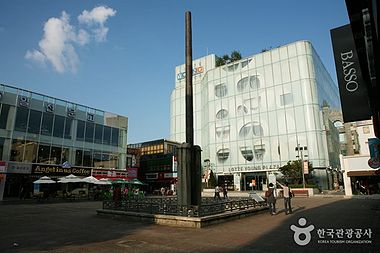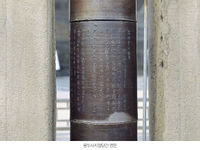청주 용두사지 철당간
| 청주 용두사지 철당간 | |
|---|---|

| |
| 지정 번호 | 국보 제41호 |
| 지정일 | |
| 지정 명칭 | 청주 용두사지 철당간 (淸州 龍頭寺址 鐵幢竿) |
| 한자 명칭 | |
| 영문 명칭 | Iron Flagpole at Yongdusa Temple Site, Cheongju |
| 분류 | |
| 건립·제작 | |
| 주소 | 충청북도 청주시 상당구 남문로2가 48-19 |
| 위도 | 36.632942 |
| 경도 | 127.489801 |
| 웹사이트 | |
국문 해설문
철당간이 서 있는 곳은 고려시대 청주의 대표적인 사찰이었던 용두사가 있던 자리이다.
신라와 고려 시대에 사찰의 건립과 함께 많은 수의 당간이 세워졌으나, 현재는 대부분 당간을 받치고 있던 지주(支柱)만이 남아 있다.
이 당간은 화강석으로 지주를 세우고 그 사이에 둥근 철통 30개를 연결하여 세운 것인데, 현재는 20개만이 남아 있다.
이 중 밑에서 세 번째의 철통에 『용두사철당기(龍頭寺鐵幢記)』가 새겨져 있다.
철당기에는 당간을 세우게 된 내력과 건립 연대, 그리고 건립에 관여한 사람들의 관직명이 적혀 있어, 당시 지방경영과 관련된 사실을 알 수 있다.
철당기의 끝에는‘ 962년 준풍(竣豊),3’에 주성(鑄成)하였다고 하여, 고려 광종 때 사용했던 독자 연호를 실물로 보여 주는 귀중한 자료이다.
아울러 이곳은 1990년대 '용두사지 철당간 보전 시민운동'의 전개로 시민들의 광장으로서 자리잡을 수 있게 되었다.

영문 해설문
This is one of very few Buddhist flagpoles remaining in its original state and is the only extant Buddhist flagpole bearing an inscription in Korea, making it a national treasure.
Up until the end of the Goryeo period (918-1392), as Buddhist temples flourished, thousands of such flagpoles were erected.
They were used for marking temple precincts by hanging flags or banners for special events and large gatherings.
In most cases, only the stone supports for such flagpoles remain.
This flagpole stands between two granite supports on the site of Yongdusa Temple, a prominent temple in the Cheongju area.
Originally, 30 iron cylinders were piled up to build the flagpole, but only 20 of them remain intact now.
The long inscription on the third cylinder from the bottom tells how it was erected in 962, and refers to the year as “the third Junpung year,” indicating that the Goryeo Dynasty once used its own reign title during its early period.
관련 항목
| 이 문서 | 관계 | 관련 문서 |
|---|---|---|
주석
- ↑ 이 당간의 건립연대와 내력을 밝혀주는 명문은 아래에서 세번째 철통 둘레에 393자 가량의 해서로 양각되어 있다. 내용은 청주의 호족인 김예종이라는 사람이 유행병에 걸리자 철당을 바쳐 절을 장엄할 것을 맹세하고 사촌형인 희일 등과 함께 철통 30단을 주조하여 높이 60척의 철당을 세우게 했다는 것이다. 출처: 한국문화유산답사회, 답사여행의 길잡이 12 - 충북, 돌베개, 2003. / 사진 출처: 한국학중앙연구원, 청주용두사지철당간, 한국민족문화대백과사전